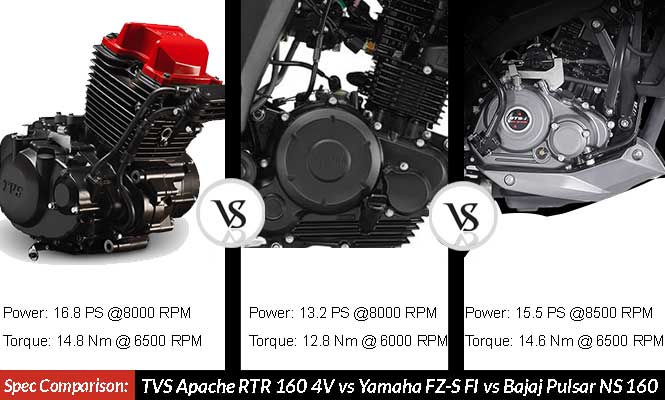



 (4 ratings)
(4 ratings)
Indian biking market is evolving every day and also the changes in the mindset of the audience from opting a budget-friendly fuel efficient commuter to performance-oriented powerful bikes made the two-wheeler manufacturers from around the world introducing much powerful, agile and performance oriented bikes in the country. Consequently, the emergence of Yamaha FZ is an evidence in the lightweight 150-160cc segment.
Following the same, various other manufacturers such as Honda, Suzuki and prominent Indian giants Bajaj and TVS Motors rolled out their products. Here we are going to compare the much advanced, termed as a Racing Machine model from TVS, the new Apache RTR 160 4V with its potent rivals Bajaj NS 160 and the Yamaha FZ Fi Version 2.0. The comparison here is done by following write down aspects.
In terms of designing all the above-mentioned bikes such as the new TVS Apache RTR 160 4V, the Bajaj Pulsar NS 160 and the Yamaha FZ Fi Version 2.0 follows the similar naked streetfighter design language. Upfront all the bikes are without covering and aggressive instance. They all feature muscular fuel tank where the new Apache RTR 160 4V and the Pulsar NS 160 wears sharp fuel extensions. The Yamaha FZ Fi V 2.0 is kind of relaxed in position in terms of sharpness.

Furthermore, they come equipped with the fat tyres which not only seem appealing but also offers an impressive grip on any kind of road surfaces. The Apache and the Pulsar NS 160 are the only models which are provided with thin tyres for its base variants. The FZ Fi V 2.0 gets fats rear tyres for all its variants. The fuel tank on all the models is a chiselled unit with enough knee recess for a better control over the bikes.
In terms of utilities and equipment, all the models are full-fledged units in the segment for taking good care of your ride. The single disc brake is offered as a standard fitment on all the products’ base variants. The extra expenditure on top end variants will also avail you with the rear disc facility. However, none of the models is being offered with the advanced safety of Anti-Lock Braking System (ABS). Whereas the suspension setup comprises telescopic front forks and rear monoshock fitment.
With the churning out of 16.8hp and 14.8Nm of peak torque, all new TVS Apache RTR 160 4V is the most powerful in all bikes. The Apache marks on 147kgs on weighing scale. Whereas lighter than former, the FZ-S is 132kg heavier and expels out 13.2 hp. The aspect that is common on all the motorcycles is the equipment of five-speed gearbox.

Engine Displacement (CCs)
Engine Cooling
Maximum Power
Maximum Torque
Fuel Supply
Top Speed
Performance wise, all the bikes are awesome as with the engine capacity ranging 150-160 segment, they can easily complete the spirints like 0-60kmph and 0-100kmph in around 16 seconds. Whereas, the ride comfort is a different thing that depends on the personality of the rider. So to check this out you have to try by sitting on all the bikes
Instrument Clusters
Ex-showroom Price (Delhi) Apache RTR 160 4V
FZS Fi Version 2.0
Pulsar NS160
| Specifications | TVS Apache RTR 160 4V | Yamaha FZ-S FI V2.0 | Bajaj Pulsar 160 NS |
|---|---|---|---|
| Capacity | 159.7cc | 149cc | 160.3 cc |
| Type | Oil Cooled | Air Cooled | Oil Cooled |
| Power | 16.8 PS @8000 RPM | 13.2 PS @8000 RPM | 15.5 PS @8000 RPM |
| Top Speed | 113 kmph | 109 kmph | 120 kmph |
| Kerb/Wet Weight | 140 kg / 142 kg | 132 kg / 133 kg | 142 kg |
| Ground Clearance | 180 mm | 160 mm | 176 mm |
| Front Suspension | Telescopic Forks | Telescopic Forks | Telescopic Forks |
| Rear Suspension | MonoShock | Monocross Swingarm | MonoShock |
| Front Brake | 270mm Petal Disc | 282mm Disc Brake | 240mm Disc |
| Rear Brake | 130mm Drum (200mm Rear Disc Option Also Available) | 220mm Disc Brake | 130mm Drum |